Mayr E.W., Pr?mel H.J., Steger A. (eds.) Lectures on Proof Verification and Approximation Algorithms
Подождите немного. Документ загружается.

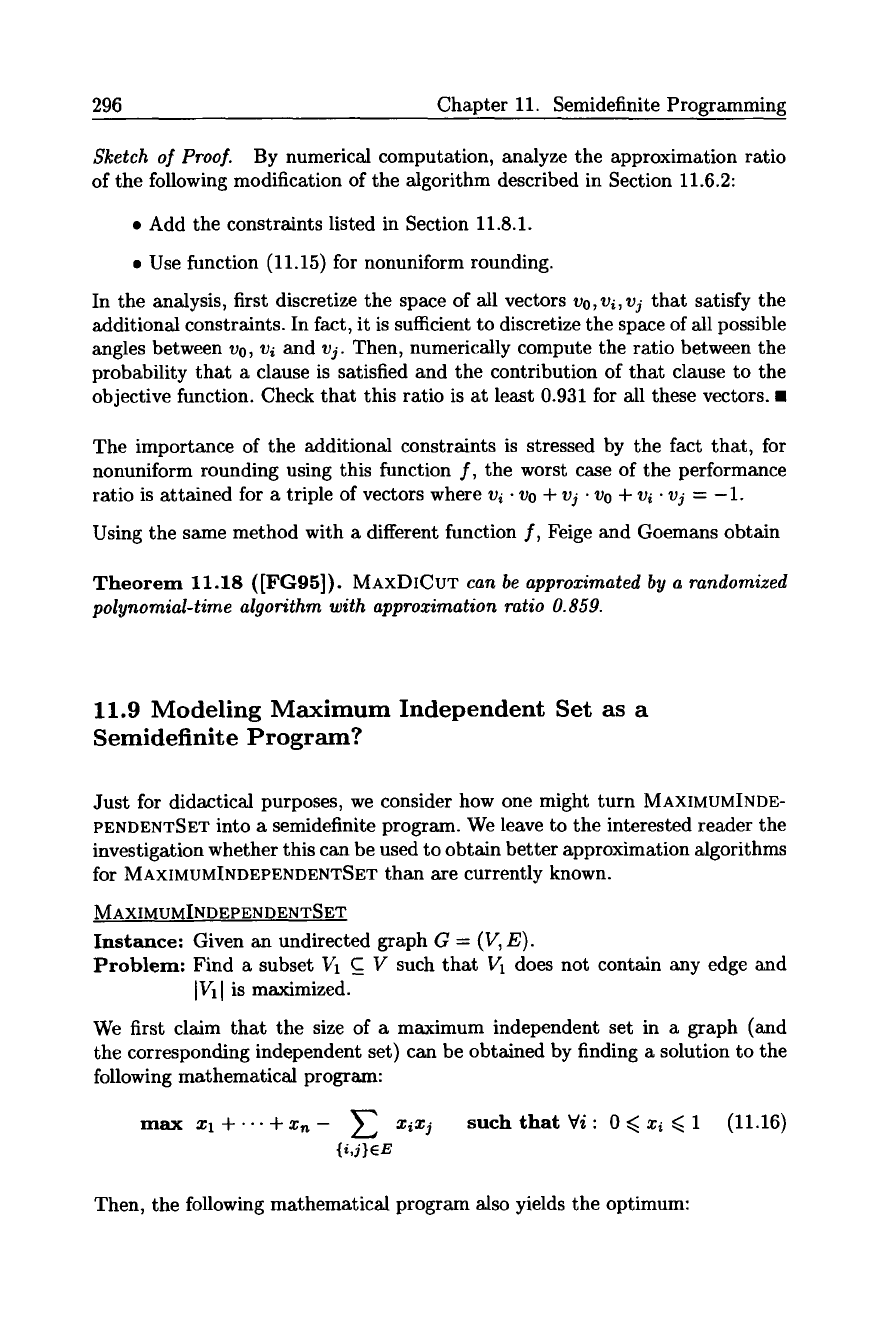
296 Chapter 11. Semidefinite Programming
Sketch of Proof. By numerical computation, analyze the approximation ratio
of the following modification of the algorithm described in Section 11.6.2:
9 Add the constraints listed in Section 11.8.1.
9 Use function (11.15) for nonuniform rounding.
In the analysis, first discretize the space of all vectors vo, vi, vj that satisfy the
additional constraints. In fact, it is sufficient to discretize the space of all possible
angles between vo, vi and vj. Then, numerically compute the ratio between the
probability that a clause is satisfied and the contribution of that clause to the
objective function. Check that this ratio is at least 0.931 for all these vectors. 9
The importance of the additional constraints is stressed by the fact that, for
nonuniform rounding using this function f, the worst case of the performance
ratio is attained for a triple of vectors where vi 9 vo + vj 9 vo + vi 9 vj = -1.
Using the same method with a different function f, Feige and Goemans obtain
Theorem 11.18 ([FG95]). MAXDICUT can be approximated by a randomized
polynomial-time algorithm with approximation ratio 0.859.
11.9 Modeling Maximum Independent Set as a
Semidefinite Program?
Just for didactical purposes, we consider how one might turn MAXIMUMINDE-
PENDENTSET into a semidefinite program. We leave to the interested reader the
investigation whether this can be used to obtain better approximation algorithms
for MAXIMUMINDEPENDENTSET than are currently known.
MAXIMUMINDEPENDENTSET
Instance:
Given an undirected graph G = (V, E).
Problem: Find a subset VI C V such that V1 does not contain any edge and
I Vll is maximized.
We first claim that the size of a maximum independent set in a graph (and
the corresponding independent set) can be obtained by finding a solution to the
following mathematical program:
max xl + .. . + xn - Z xixj
such thatVi:
0<~xi~l (11.16)
Then, the following mathematical program also yields the optimum:
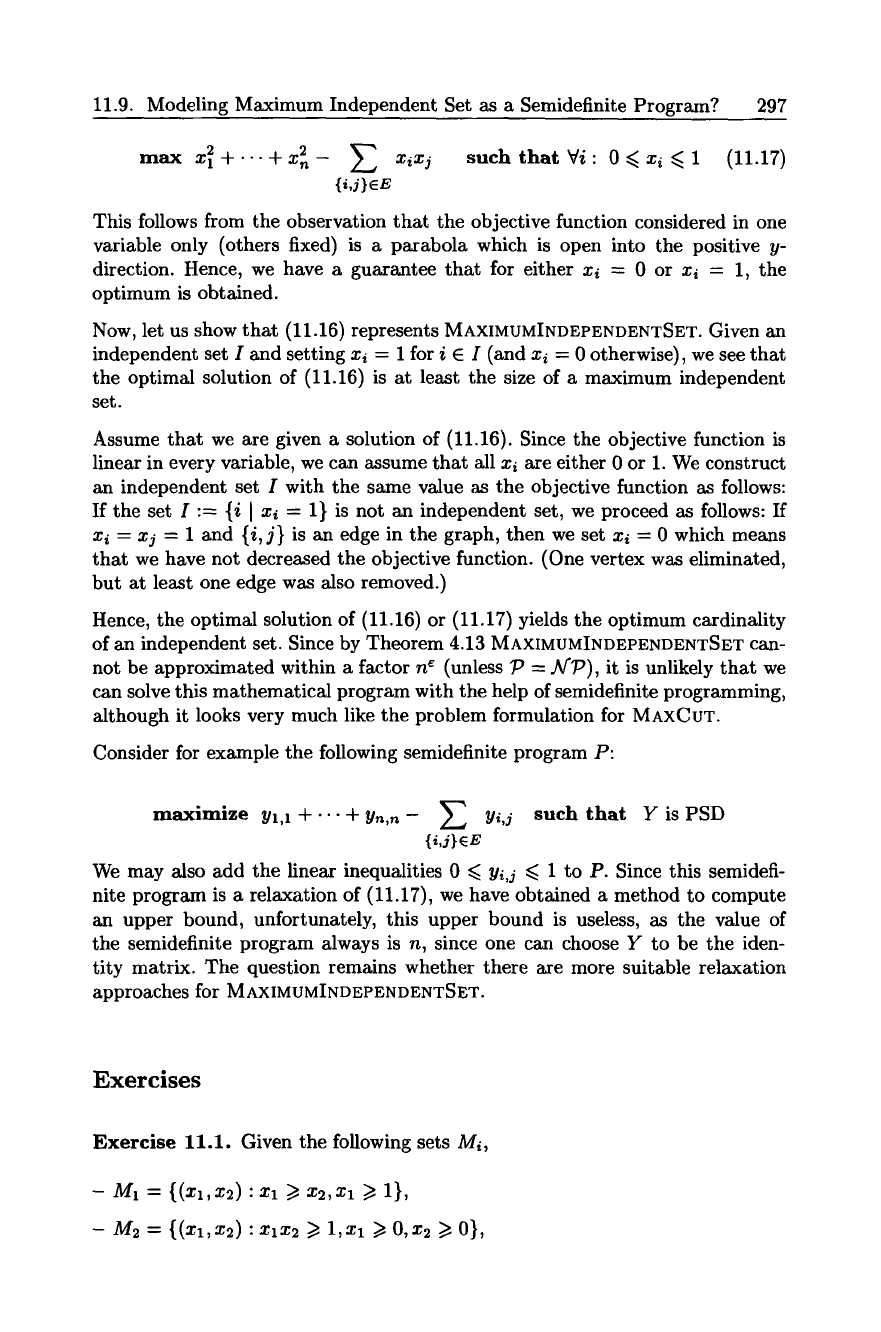
11.9. Modeling Maximum Independent Set as a Semidefinite Program? 297
2
max x 2+...+x n- Z xixj
such that
Vi: 0~xi~l (11.17)
{i,j}eE
This follows from the observation that the objective function considered in one
variable only (others fixed) is a parabola which is open into the positive y-
direction. Hence, we have a guarantee that for either
xi = 0
or xi = 1, the
optimum is obtained.
Now, let us show that (11.16) represents MAXIMUMINDEPENDENTSET. Given an
independent set I and setting xi = i for i E I (and
xi = 0
otherwise), we see that
the optimal solution of (11.16) is at least the size of a maximum independent
set.
Assume that we are given a solution of (11.16). Since the objective function is
linear in every variable, we can assume that all xi are either 0 or 1. We construct
an independent set I with the same value as the objective function as follows:
If the set I := (i I xi = 1} is not an independent set, we proceed as follows: If
xi = xj = 1 and {i,j}
is an edge in the graph, then we set xi = 0 which means
that we have not decreased the objective function. (One vertex was eliminated,
but at least one edge was also removed.)
Hence, the optimal solution of (11.16) or (11.17) yields the optimum cardinality
of an independent set. Since by Theorem 4.13
MAXIMUMINDEPENDENTSET can-
not be approximated within a factor n e (unless P = ALP), it is unlikely that we
can solve this mathematical program with the help of semidefinite programming,
although it looks very much like the problem formulation for MAXCUT.
Consider for example the following semidefinite program P:
maximize
Yl,1 -{- "'" -{-
Yn,n - ~ Yl,j
such that
Y is PSD
{i,j)eE
We may also add the linear inequalities 0 ~< Yi.j ~< 1 to P. Since this semidefi-
nite program is a relaxation of (11.17), we have obtained a method to compute
an upper bound, unfortunately, this upper bound is useless, as the value of
the semidefinite program always is n, since one can choose Y to be the iden-
tity matrix. The question remains whether there are more suitable relaxation
approaches for
MAXIMUMINDEPENDENTSET.
Exercises
Exercise II.I. Given the following sets Mi,
- M1 = {(xl, x2) :
~1 ~ 3~2, Xl
~ 1},
- M2 = {(=1,x2) : xlx2 >/1,~1 >/0,x~ >/0},
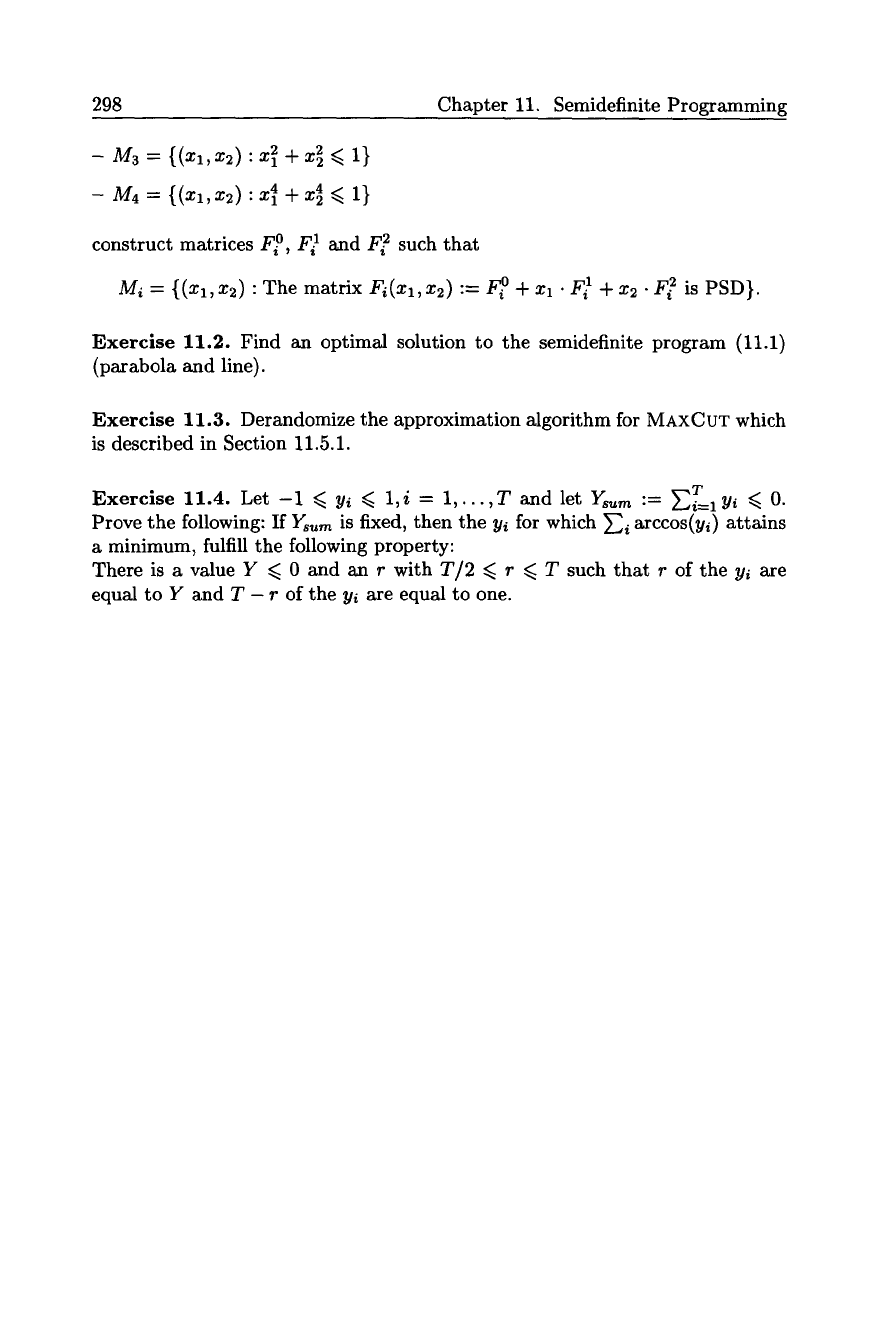
298 Chapter 11. Semidefinite Programming
- M3 = {(xl,x2): x~ + x~ ~ 1}
- M4 = {(xl, x2): ~ + ~ <~ 1}
construct matrices F ~ F~ and F 2 such that
M/= {(xl,x2) : The matrix
Fi(Xl,X2) := F ~ + xl . F~ + x2 . F 2
is PSD}.
Exercise 11.2. Find an optimal solution to the semidefinite program (11.1)
(parabola and line).
Exercise 11.3. Derandomize the approximation algorithm for MAxCUT which
is described in Section 11.5.1.
Exercise 11.4. Let -1 ~< yi ~ 1,i = 1,...,T and let Ys~rn :=
~T=lY~ <~ O.
Prove the following: If Ys,m is fixed, then the Yi for which ~i arccos(yi) attains
a minimum, fulfill the following property:
There is a value Y ~< 0 and an r with
T/2 <~ r <~ T
such that r of the Yi are
equal to Y and T - r of the yi are equal to one.

12. Dense Instances of Hard
Problems
Katja Wolf
Optimization
12.1 Introduction
Some years ago only very few optimization problems like
KNAPSACK were
known
to have polynomial time approximation schemes. Since the PCP-Theorem im-
plies that all APX-hard problems are unlikely to permit a PTAS, a consequent
approach is to look for those subclasses which are easier to handle with respect to
approximation. Baker [Bak94] shows that several A/P-hard graph problems have
a PTAS on planar graphs. Chapter 13 is devoted to the construction of PTASs
for the TRAVELING
SALESMAN
problem and the k-MsT problem in Euclidean
metric spaces. Recently, research has been extended to the approximability of a
large class of problems, including MAXCUT and MAxEkSAT, on dense instances.
The topic of this chapter is to survey the approximation results that have been
achieved in this area.
We give a definition of density which depends on the type of the problem we
consider.
Definition
12.1.
A graph with n vertices is
dense
if it has
~(n 2)
edges. It is
everywhere dense
if the minimum degree of the graph is f~(n). A
kSAT
formula
in n Boolean variables is
dense
if it consists of f~(n k) clauses.
We shall follow the work of Arora, Karger and Karpinski [AKK95a], who com-
bine randomized sampling and rounding techniques with linear programming
to design a scheme with additive approximation guarantee for smooth integer
programs.
Definition
12.2.
Let p E
Z[xl,...,xn]
be a degree d polynomial with integer
coel~icients, p is called
smooth,
if the coej~icients preceding each term of degree
i are bounded by a constant factor times n d-i.
A smooth degree d integer program
has the objective
maximize
(minimize) p(xl,...,Xn)
subject to x~E {0,1} for l~<i~n.
The central result is the following theorem.
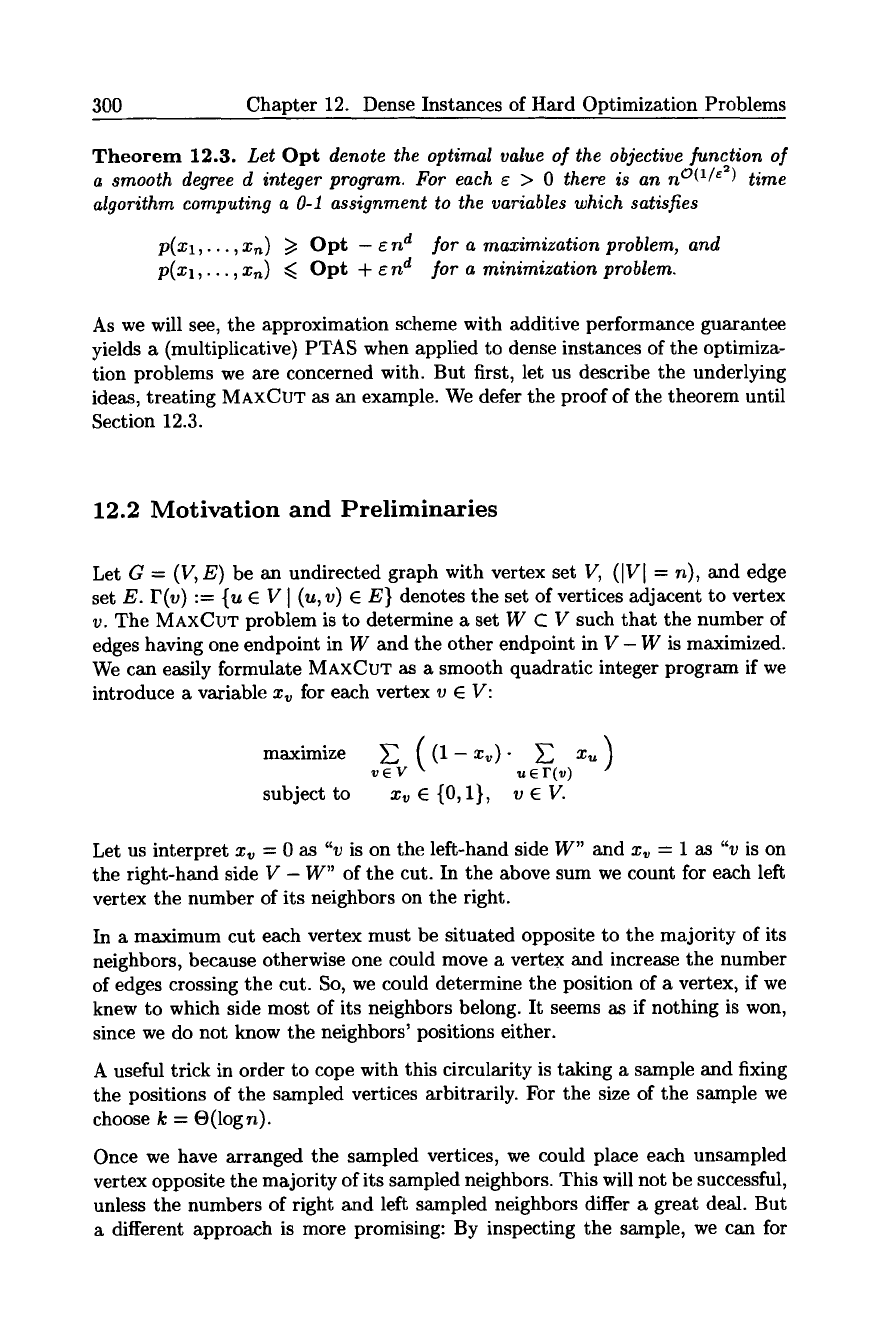
300 Chapter 12. Dense Instances of Hard Optimization Problems
Theorem 12.3. Let Opt denote the optimal value of the objective function of
a smooth degree d integer program. For each ~ > 0 there is an n O(1/e2) time
algorithm computing a 0-1 assignment to the variables which satisfies
p(xl,...,Xn) >1 Opt - end for a maximization problem, and
p(xl,...,Xn) <~ Opt + end for a minimization problem.
As we will see, the approximation scheme with additive performance guarantee
yields a (multiplicative) PTAS when applied to dense instances of the optimiza-
tion problems we are concerned with. But first, let us describe the underlying
ideas, treating MAXCUT as an example. We defer the proof of the theorem until
Section 12.3.
12.2 Motivation and Preliminaries
Let G = (V,E) be an undirected graph with vertex set V, (IV[ = n), and edge
set E. F(v) := {u 9 V [ (u, v) 9 E} denotes the set of vertices adjacent to vertex
v. The MAXCUT problem is to determine a set W C V such that the number of
edges having one endpoint in W and the other endpoint in V - W is maximized.
We can easily formulate MAXCUT as a smooth quadratic integer program if we
introduce a variable Xv for each vertex v 9 V:
maximize ~ ((1-x~)- ~ x~)
vEV uEr(v)
subject to xve{0,1}, v9
Let us interpret Xv = 0 as "v is on the left-hand side W" and xv -- 1 as "v is on
the right-hand side V - W" of the cut. In the above sum we count for each left
vertex the number of its neighbors on the right.
In a maximum cut each vertex must be situated opposite to the majority of its
neighbors, because otherwise one could move a vertex and increase the number
of edges crossing the cut. So, we could determine the position of a vertex, if we
knew to which side most of its neighbors belong. It seems as if nothing is won,
since we do not know the neighbors' positions either.
A useful trick in order to cope with this circularity is taking a sample and fixing
the positions of the sampled vertices arbitrarily. For the size of the sample we
choose k = O(log n).
Once we have arranged the sampled vertices, we could place each unsampled
vertex opposite the majority of its sampled neighbors. This will not be successful,
unless the numbers of right and left sampled neighbors differ a great deal. But
a different approach is more promising: By inspecting the sample, we can for
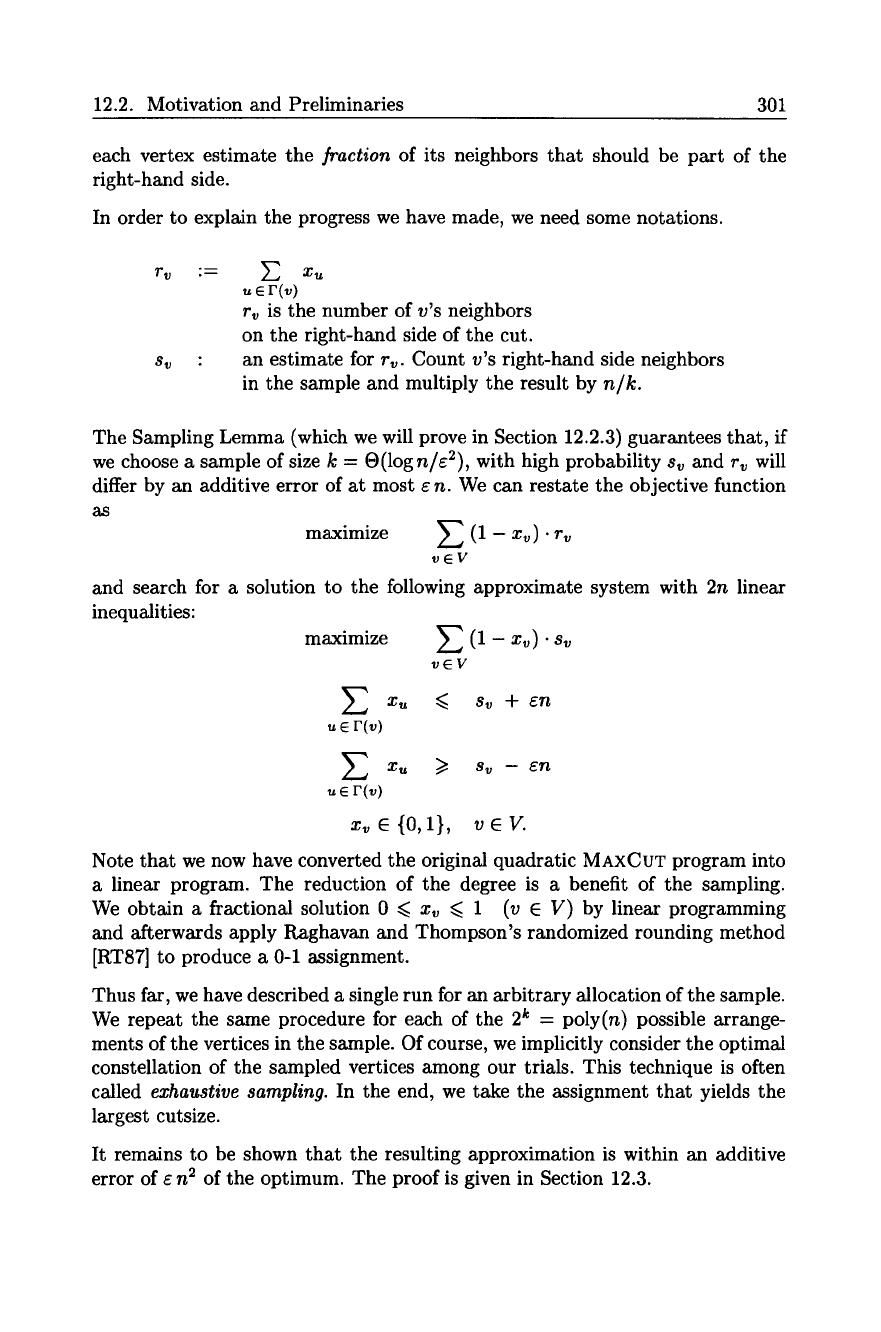
12.2. Motivation and Preliminaries 301
each vertex estimate the
]raction
of its neighbors that should be part of the
right-hand side.
In order to explain the progress we have made, we need some notations.
r v :~
8 v :
Xu
u 9 r(v)
rv is the number of v's neighbors
on the right-hand side of the cut.
an estimate for rv. Count v's right-hand side neighbors
in the sample and multiply the result by
n/k.
The Sampling Lemma (which we will prove in Section 12.2.3) guarantees that, if
we choose a sample of size k = O(logn/r with high probability sv and rv will
differ by an additive error of at most ~ n. We can restate the objective function
as
maximize Z (1 - xv). r~
vEV
and search for a solution to the following approximate system with 2n linear
inequalities:
maximize
Z (1-
xv) .sv
vEV
e r(~)
Z xu >I sv
cn
u e r(v)
x~ E {0,1},
veV.
Note that we now have converted the original quadratic MAXCUT program into
a linear program. The reduction of the degree is a benefit of the sampling.
We obtain a fractional solution 0 ~<
Xv <~ 1 (v E V)
by linear programming
and afterwards apply Raghavan and Thompson's randomized rounding method
[RT87] to produce a 0-1 assignment.
Thus far, we have described a single run for an arbitrary allocation of the sample.
We repeat the same procedure for each of the 2 k = poly(n) possible arrange-
ments of the vertices in the sample. Of course, we implicitly consider the optimal
constellation of the sampled vertices among our trials. This technique is often
called
exhaustive sampling.
In the end, we take the assignment that yields the
largest cutsize.
It remains to be shown that the resulting approximation is within an additive
error of ~ n 2 of the optimum. The proof is given in Section 12.3.
Z xu ~< sv § ~n

302 Chapter 12. Dense Instances of Hard Optimization Problems
12.2.1 Chernoff Bounds
Before we go into the details of randomized rounding and random sampling, let
us briefly review Chernoff bounds to gain insight into the technical background of
the method. The analysis of the rounding procedure is quite intricate, because we
allow negative coefficients and must derive suitable tail bounds for the deviation
of a random variable from its mean.
Lemma
12.4. Let X1, . . . , Xn be independent Bernoulli random variables,
Prob[X~ = 1] = Pi = 1 - Prob[Xi = 0].
and let Wl,..., wn e [0, 1]. X denotes the weighted sum of the Bernoulli trials,
X = ~-~inl w~X~, and # = E[X]. Then the following inequality holds
Prob [IX-~l >t] ~< 2e -2.~/" for t > O.
For a proof of the lemma we direct the reader to [Hoe63] or to [MR95b]. It is
conducted in a similar way as the proof of Theorem 3.5.
Corollary 12.5. For each f > 0 there is a constant c > 0 such that under the
assumptions of Lemma 12.4
Prob [I x-#l>c~] ~< 2n -s.
Pro@ We apply Lemma 12.4 with t := e ~]r~-n and e = ~ and obtain
Prob[IX-#l>c nlx/-n-i~] ~< 2e-2C~log n ~< 2n -2c2 ~<2n-I.
Lemma 12.6 (Positive and Negative Variables).
Let X1,..., Xn be independent Bernoulli random variables such that {1,... ,n}
is the disjoint union of two sets I and J, and 0 <<. wi <~ 1 for i E I, and
-1 <~ wj ~ O forj E J.
Then for each f > 0 there are constants Cl > 0 and c2 > 0 such that
Prob fIX - > cl ] .< c2n-s
Sketch of Proof. We define
X(1) = ZwiXi' #(1) = E[X(1)], X(2) = ~
wjXj,
~(2) = E[X(2)].
zEI jEJ
Note that IX -/x I ~< IX 0) - #(1)[ + I - X(2) - (-#(2))1, so we can apply Corollary
12.5 to X (1) and to -X (2) and combine the resulting inequalities appropriately. 9
Remark 12.7. As common in the literature, we use the term with high proba-
bility to express that the probability is 1 - n -n0) when n tends to infinity.
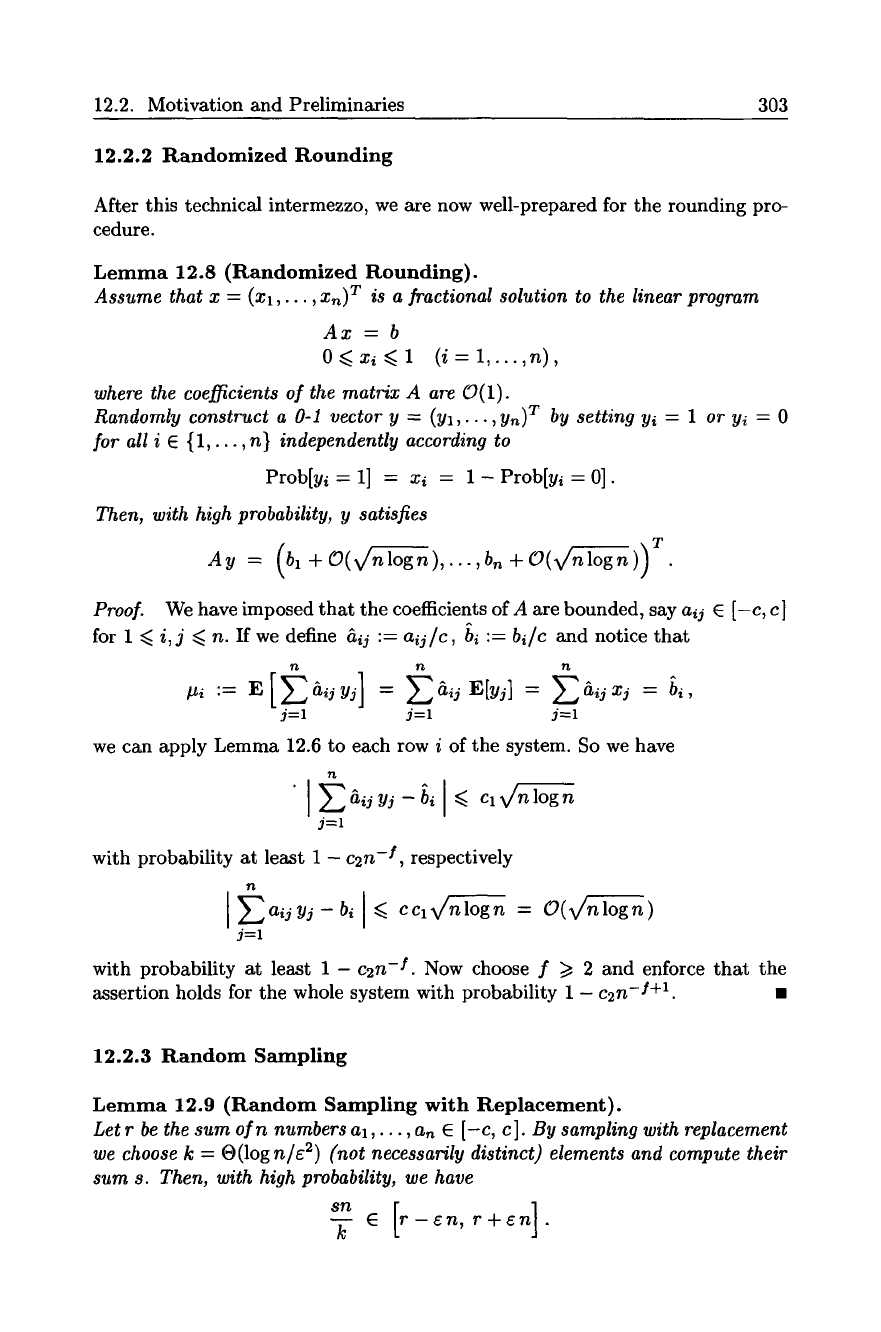
12.2. Motivation and Preliminaries 303
12.2.2 Randomized Rounding
After this technical intermezzo, we are now well-prepared for the rounding pro-
cedure.
Lemma 12.8 (Randomized Rounding).
Assume that x = (xl,..., Xn) T is a fractional solution to the linear program
Ax=b
O~xi~l (i = 1,...,n),
where the coefficients of the matrix A are O(1).
Randomly construct a 0-1 vector y = (Yl,.--,Yn) T by setting yi = 1 or yi = 0
for all i 9 {1,... , n} independently according to
Prob[yi=l] = xi = 1-Prob[yi=0].
Then, with high probability, y satisfies
A y :
(b 1 -~-O(~nlogn),...,b n
-~- O( nvf~-~ )) T
Proof. We have imposed that the coefficients of A are bounded, say a 0 9 [-c, c ]
for 1 <~ i,j <. n. If we define &q := ao/c , bi := bile and notice that
j=l j=l j=l
we can apply Lemma 12.6 to each row i of the system. So we have
"lZhijyj-bil<. cl v/-n log n
j=l
with probability at least 1 - c2n -I, respectively
n
[ ~aoy j -bi I <~ cc, v/'nlogn = O(v~logn)
j=l
with probability at least 1 - c2n -I. Now choose f >/ 2 and enforce that the
assertion holds for the whole system with probability 1 - c2n -I+1. 9
12.2.3 Random Sampling
Lemma 12.9 (Random Sampling with Replacement).
Let r be the sum of n numbers al,..., an E [-c, c]. By sampling with replacement
we choose k = O(logn/c 2) (not necessarily distinct) elements and compute their
sum s. Then, with high probability, we have
k E -en, r+en .
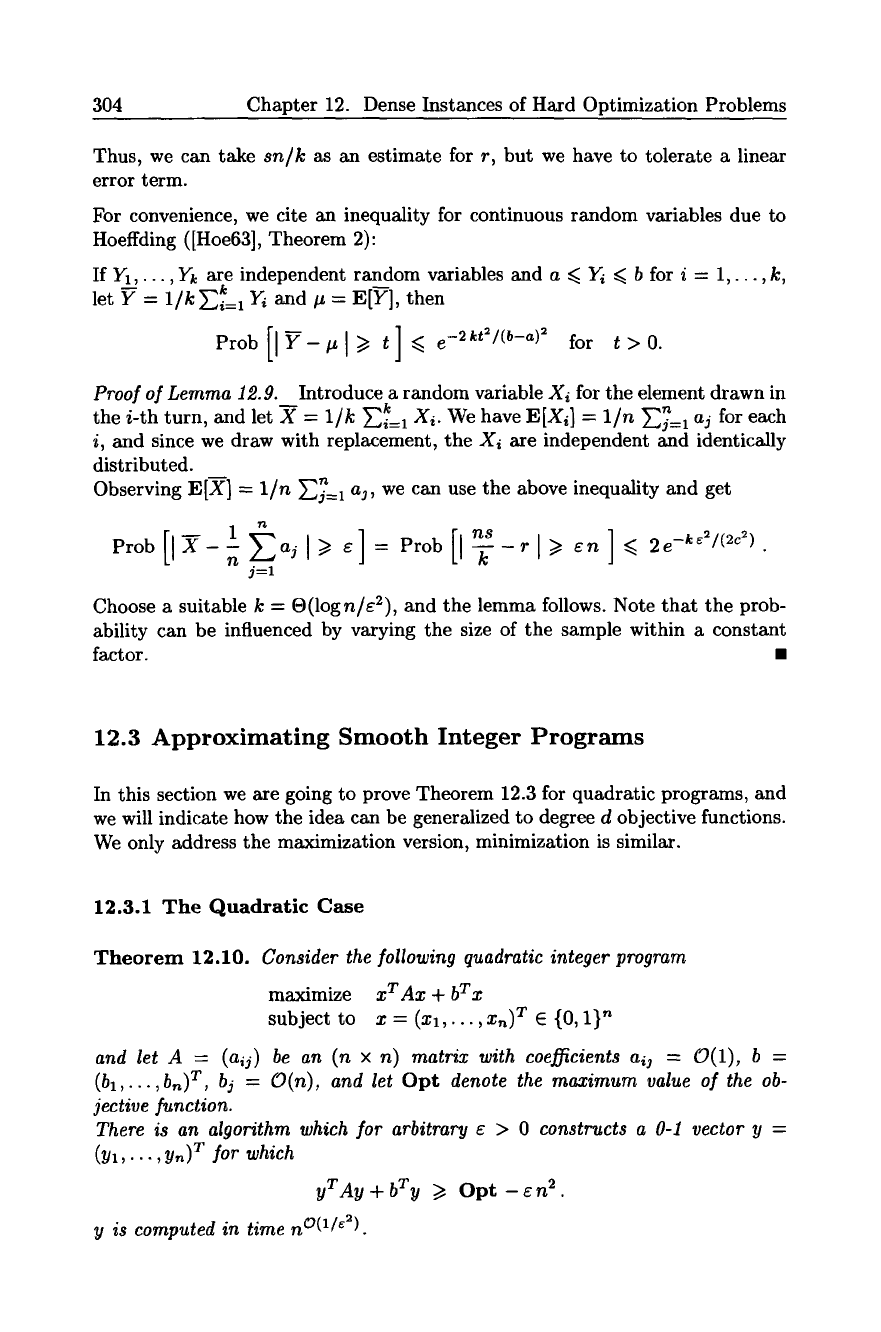
304 Chapter 12. Dense Instances of Hard Optimization Problems
Thus, we can take sn/k as an estimate for r, but we have to tolerate a linear
error term.
For convenience, we cite an inequality for continuous random variables due to
Hoeffding ([Hoe63], Theorem 2):
If Y1,... ,Yk are independent random variables and a ~< Y/~ b for i = 1,... ,k,
let Y 1/k k = E[Y], then
= Ei=I
Yi and p
Prob[lY-/~l~> t]<~
e -2kt2/(b-a)2
for t>0.
Proof of Lemma 12.9. Introduce a random variable Xi for the element drawn in
the i-th turn, and let X 1/k k X n
: ~i=1 ~. We have E[Xi] = 1In ~j=l aj for each
i, and since we draw with replacement, the Xi are independent and identically
distributed.
-- n
Observing E[X] = 1/n ~j=t a3, we can use the above inequality and get
[ ns ] 2e_ke2/(2c2 )
Prob[IX -1 aCid> ~]= Prob ~=
<.
n
5=1
Choose a suitable k = O(logn/e2), and the lemma follows. Note that the prob-
ability can be influenced by varying the size of the sample within a constant
factor. 9
12.3 Approximating Smooth Integer Programs
In this section we are going to prove Theorem 12.3 for quadratic programs, and
we will indicate how the idea can be generalized to degree d objective functions.
We only address the maximization version, minimization is similar.
12.3.1 The Quadratic Case
Theorem
12.10. Consider the following quadratic integer program
maximize xT Ax + bT x
subject to x = (Xl,...,xn) T E {0,1} n
and let A = (aij) be an (n x n) matrix with coefficients ai3 = O(1), b =
(bl,...,bn) T, bj = O(n), and let Opt denote the maximum value of the ob-
jective function.
There is an algorithm which for arbitrary ~ > 0 constructs a 0-1 vector y =
(Yl,..-,Yn) T for which
yTAy-4-bTy >/ Opt--~n 2.
y is computed in time n ~
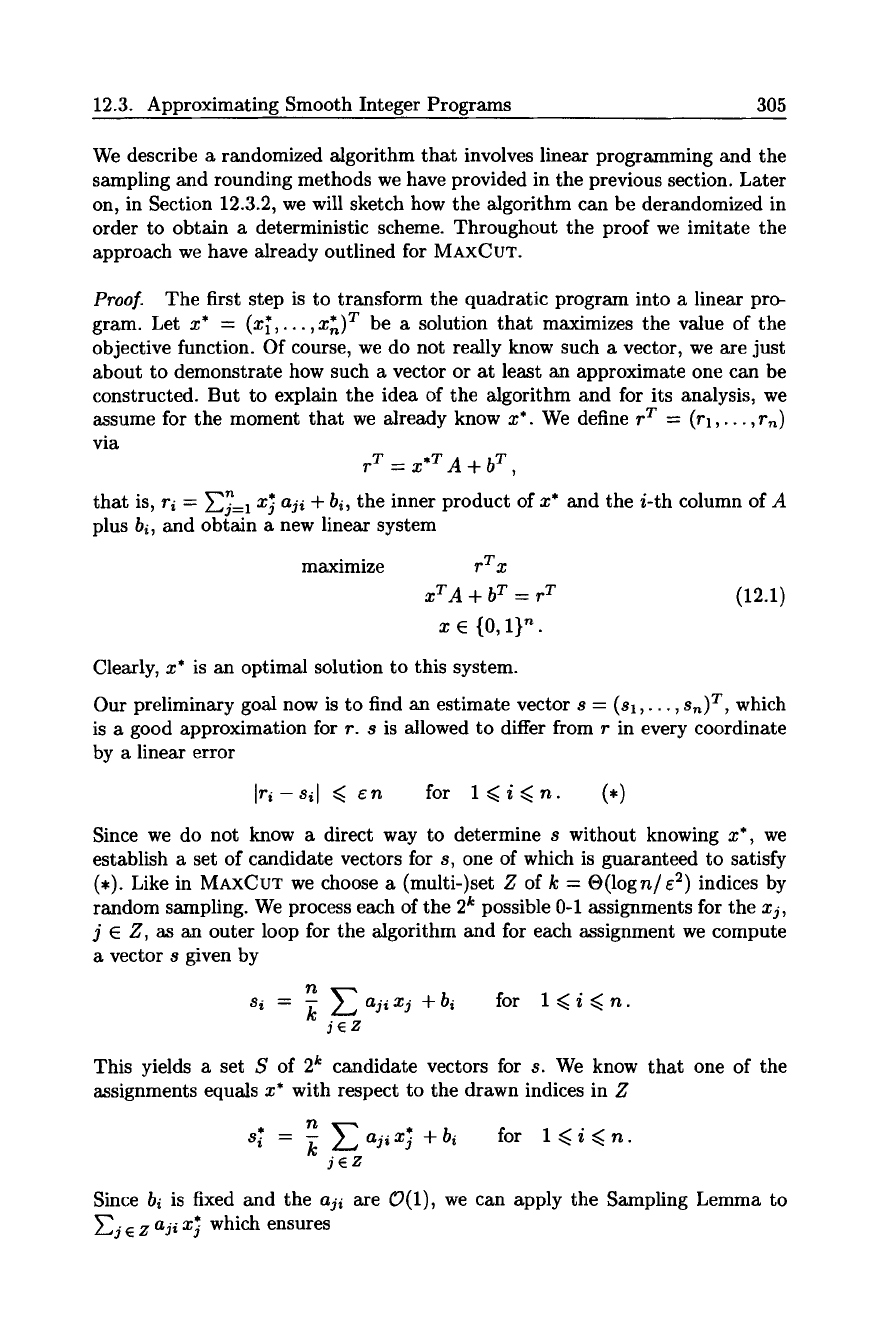
12.3. Approximating Smooth Integer Programs 305
We describe a randomized algorithm that involves linear programming and the
sampling and rounding methods we have provided in the previous section. Later
on, in Section 12.3.2, we will sketch how the algorithm can be derandomized in
order to obtain a deterministic scheme. Throughout the proof we imitate the
approach we have already outlined for MAXCUT.
Proof.
The first step is to transform the quadratic program into a linear pro-
gram. Let
x* = (x~,... ,x*) T
be a solution that maximizes the value of the
objective function. Of course, we do not really know such a vector, we are just
about to demonstrate how such a vector or at least an approximate one can be
constructed. But to explain the idea of the algorithm and for its analysis, we
assume for the moment that we already know x*. We define
r T
-- (rl,...,
rn)
via
r T ~ x *T A + b T ,
n
that is,
ri = ~,j=l xj aji + bi,
the inner product of x* and the i-th column of A
plus
bi,
and obtain a new linear system
maximize
rT x
xTA q- b T = r T
(12.1)
x e {0,
1}'.
Clearly, x* is an optimal solution to this system.
Our preliminary goal now is to find an estimate vector
s = (sl,..., sn) T,
which
is a good approximation for r. s is allowed to differ from r in every coordinate
by a linear error
[ri - si[ <<. en
for l~<i~<n. (*)
Since we do not know a direct way to determine s without knowing x*, we
establish a set of candidate vectors for s, one of which is guaranteed to satisfy
(,). Like in MAXCUT we choose a (multi-)set Z of k = O(logn/s 2) indices by
random sampling. We process each of the 2 k possible 0-1 assignments for the
xj,
j E Z, as an outer loop for the algorithm and for each assignment we compute
a vector s given by
n
si = ~ Z aji xj + bi
for 1 ~< i ~< n.
jEZ
This yields a set S of 2 k candidate vectors for s. We know that one of the
assignments equals x* with respect to the drawn indices in Z
n ,
S 7 = ~ ~ajixj +bi
for
l<~i<<.n.
jEz
Since
bi
is fixed and the
aji are
O(1), we can apply the Sampling Lemma to
~j e z aji x~ which ensures
